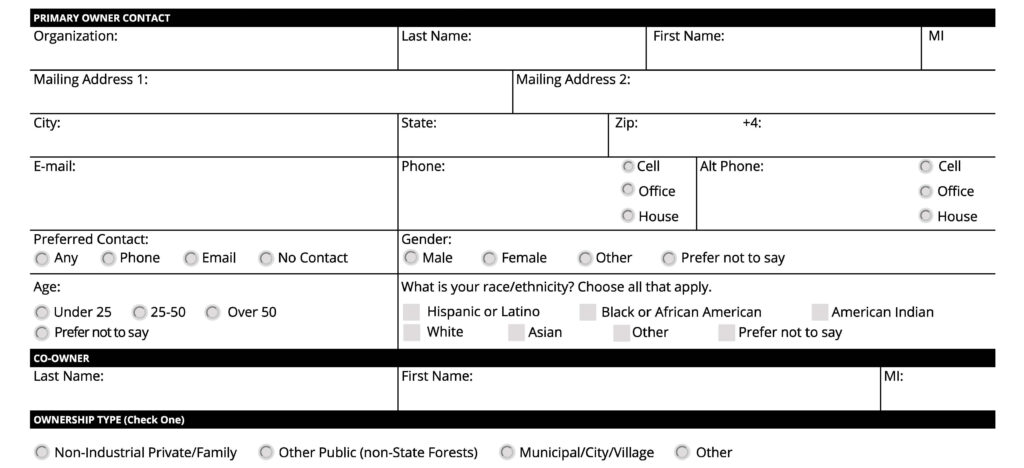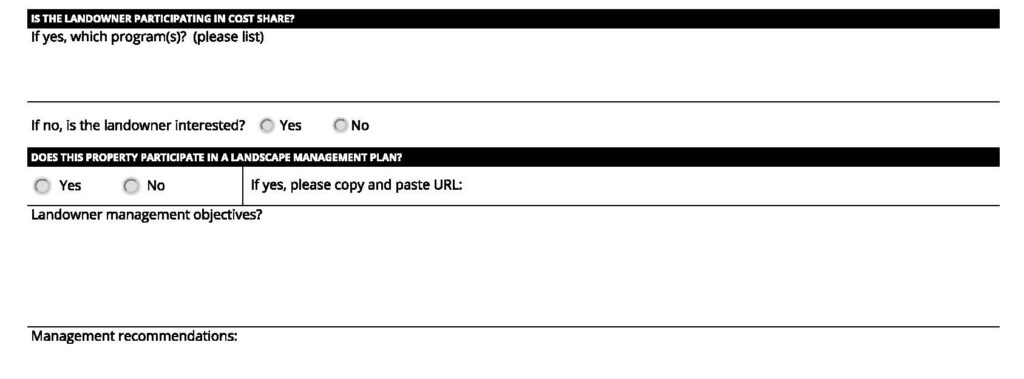Pages 1 and 2 of the Inspection Form
The first page and a half of the Tree Farm Inspection Record is where the inspector records information about the landowner, the property and the inspection process. Below is guidance on how to fill out each section of the report. Additional guidance is available in this section of the Tune Up Your Tree Farm Inspector Skills webinar

The Tree Farm Number is a unique identifier for each certified property.
- The State and Tree Farm Number fields will be prepopulated for re-inspections.
- For new Tree Farms, leave these fields blank. The N.C. Tree Farm Program will assign a Tree Farm number to the property when it processes the inspection report and approves certification.

- This section is for initial inspections only. Do not fill out this section for re-inspections.
- Check Certified/Recognition to indicate that you, as the inspector, recommend that the property be certified. If you find that the property does not qualify for certification during your inspection, do not submit an inspection record.
- Check the relevant box(es) to indicate how the landowner learned of the Tree Farm Program.

- This section is for re-inspections only. Do not fill out this section for new Tree Farms.
- Check the appropriate box to indicate whether you recommend Recertification/Renewal, moving the property to Pioneer status or Decertification.
- Before checking Pioneer, consult with the N.C. Tree Farm Program for guidance. The N.C. Tree Farm Program uses the Pioneer category for properties that do not meet the certification requirements but the landowner intends to correct any non-compliant issues within the next six months. The property is technically decertified but the decertification is expected to be temporary.
- If recommending Decertification, indicate the reason by checking the appropriate box:
- Deceased: The primary landowner is no longer living and there are no immediate family members who want to maintain certification.
- Sold: The property has been sold outside of the immediate family.
- Missing: You have been unable to locate the landowner using the available contact information and have contacted the N.C. Tree Farm Program for assistance. No additional leads for reaching the landowner are available.
- Substandard: The forest management or management documentation does not meet certification standards, and the landowner does not intend to take corrective action within the next six months.
- No Interest: The landowner is no longer interested in being in the N.C. Tree Farm Program. If known, record the reason for No Interest in the Notes/Updates section on the middle of page 2.

- Under Field Inspection Date, record the date that you visited the Tree Farm. The field inspection must be within six months of submitting the inspection report with no management activities occurring since the visit.
- Under Remote/Interview Date, record the date that you communicated with the landowner about certification or recertification.
- For Type of Interview, check the appropriate box.

This section is where the inspector records the name, contact information and demographics for the primary owner.
- For new Tree Farms, fill out all of the fields.
- For re-inspections, most, if not all, of the fields will be pre-populated. Confirm with the landowner that the information is up to date, collect missing information and make edits on the form as needed. If the ownership has changed, provide the new owner’s name and contact information in the Notes/Updates section on page 2.
- If there is a co-owner, provide the co-owner’s name in the Co-Owner field and that person’s contact information in the Notes/Updates section on page 2.
- If the primary contact is different from the primary owner, include that person’s name and contact information (phone, email, address) in the Notes/Updates section on the middle of page 2 and note that this is the primary contact for the property.
- Indicate the ownership type by checking the appropriate box.

- List the county where the Tree Farm is located. If the property crosses a county line, provide the name of the county where most of the acreage is located.
- Provide the name of the nearest town. If there is no town nearby, leave this section blank.
- For Total Acres, include all acreage in contiguous tax parcels under a single ownership. Contiguous parcels are those that share a boundary line or corner, or are separated by no more than 84 feet (the approximate width of a two-lane state road). Non-contiguous tracts that are less than 10 acres and thus do not qualify for certification on their own may be certified with a qualifying tract. If that is the case, include that non-contiguous acreage in the Total Acres and Forested Acres and include in the Notes/Updates section on page 2 the location of the smaller tract.
- Forested Acres includes wooded acreage as well as food plots, water resources (ponds, streams) and small, non-forested areas that are integrated into the forest management system. Residential areas, crops and large water bodies are not included in forested acreage.
- Provide acreage in whole numbers, rounding fractional acreage to the nearest whole number.
- Provide the Longitude and Latitude in decimal degree format (dd.dddd) for the main entrance to the property.
- Answer Yes if the owner lives on the property or within one mile of the property. Otherwise answer No.

Primary soil is the type of soil that is most prevalent on the property. Secondary soil is the second most common soil on the property. The primary and secondary soils could be the same type. If the primary soil type is Wickham fine sandy loam, check Loam. If the secondary soil type is Norfolk loamy sand, check Sand.

Check all of the conservation activities that the landowner is participating in. Examples of conservation activities to note include when:
- There is a conservation easement on the property.
- The landowner conducts prescribed burns and installed firebreaks to reduce wildlife risk.
- The property is enrolled in the Safe Harbor Program to protect red-cockaded woodpecker habitat.
- The landowner is restoring a longleaf pine/wiregrass ecosystem.

- Provide information on any cost-share programs in which the landowner is participating.
- If the landowner is not in any cost-share programs, answer Yes or No as to whether the landowner is interested in participating.
- North Carolina does not have a landscape management plan, so answer No to the question about participation.
- Record the landowner’s primary management objectives if they are not described in the forest management plan or if the landowner’s objectives have changed since the plan was developed.
- Record any management recommendations that you may have to help meet the landowner’s objectives. If you have no recommendations beyond those found in the management plan, write “See forest management plan for management recommendations.”
![]()
Under Notes/Updates, record any important information or updates regarding the Tree Farm, ownership, acreage or contacts not recorded in other sections of the inspection report.

- New certifications require the landowner’s signature. Re-inspections do not require a signature.
- When a signature is required, the landowner may authorize the use of a typed signature by checking the box acknowledging that a typed or written signature constitutes a legal signature.
- The section labeled Qualified ATFS Inspector Signature is where the inspector must sign the inspection form. A typed signature is acceptable.
- Under Recommendation, the inspector must check the appropriate box.
- Provide the inspector’s full name where it says First Name MI Last Name.
- ID# refers to the inspector identification number. This field will be prepopulated on re-inspections. For new inspections, the N.C. Tree Farm Program will complete this field for the inspector.
